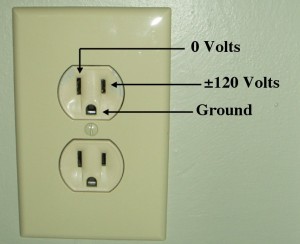Physicist: Ground.

You can put a paperclip practically anywhere. All the same, don't try it.
The zero volt, large-slit wire is called the “return” or “neutral” line. If it seems strange that the power company would supply you with a wire that has no voltage, keep in mind that what you really need is a voltage difference. That’s why everything that uses electricity has at least two wires connecting it to its power supply.

Green=ground, Black=120v, White=neutral. Notice that you can easily remove the green lines on the right without actually affecting anything.
The difference between the neutral line and the ground line is that the neutral line carries current (all the current that enters through the 120 volt line has to go back out), while the ground line is literally connected to the ground (usually through your plumbing) and carries no current. The ground and neutral lines are spliced together at the fuse box (and generally again out by the local transformer). You’d expect that since the lines are connected there’s no difference between them, and that’s almost entirely true. The ground line, having no current and a shorter path to the ground, is always at exactly 0 volts, which is important information for many electronic devices to have access to.
In your house it’s important for most electronics to have a wire to dump energy out of in case of a short. This can be the ground or neutral lines, since they’re practically identical. If a device needs to know the difference between the 120v and neutral lines, then it will have one big tine and one small one at the end of its cord. So when you’re wiring up a house it’s important to keep track of which line is the 120v line and which is the neutral line. A good way to keep track is to wire up outlets with a temporary connection between the ground and neutral lines during installation, so that if the electrician accidentally switches the 120v and neutral lines there will be a flash, a pop, a puff of smoke, and no lights. So that’s one use for the nearly useless ground line.
It’s a bad idea in general to connect the neutral and ground lines. Nothing bad will happen (if the wiring is up to code), but you will be creating a loop (check the figure above and connect the white and green lines at an outlet). Loops are bad because they turn changing magnetic fields into changing electric current (and vice versa). There are plenty of random magnetic fields out there, so you’d be introducing an unpredictable source of current to your electrical system. Still, you’d probably never notice if the loop is relatively small (say, smaller than an entire house).
So the reason that ground lines run to outlets is that every now and then it’s nice to have access to a 0 volt, 0 current wire. But it’s not really that important, which is why so many outlets don’t have a third hole.







9 Responses to Q: What’s that third hole in electrical outlets for?